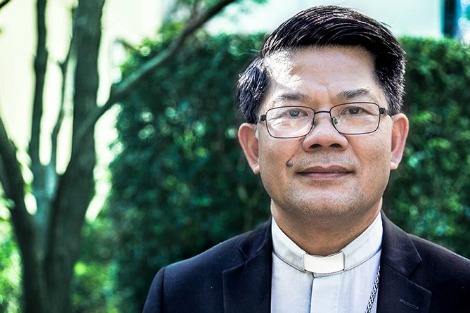Clarity beyond Clericalism: Bishop Long at the Royal Commission
By Andrew Hamilton
Nothing should be allowed to minimise the evil represented in them. The panels of people interviewed offer some evidence, nonetheless, that children will now be safer when under Catholic care. The most thought provoking testimony given was that by Vincent Long, Bishop of Parramatta. It was notable for its directness, honesty and the awareness it displayed of the importance of church culture. Bishop Long grew up in the Vietnamese Catholic Church and was afterwards chosen to lead the Australian Church. In his responses he focused particularly on clericalism and its role in giving license and cover to clerical abuse. He worked out of a fairly simple distinction between two images of the church. One sees the church as a kingdom in which the subordination of the people to the king and to the hierarchical grades of officials is fixed and sacralised. The other is of the church as community with an ordered network of relationships that enable the nourishing of people by the spreading of the Gospel. He associated clericalism with the first image, commended by Popes John Paul II and Benedict XVI. The communal vision was identified with the Vatican II and Pope Francis. This distinction is often made. Bishop Long's contribution to it lay in his sensitivity to the way in which particular cultures mould themselves to metaphor to affect practice. In the Vietnamese church he saw a culture with a high acceptance of hierarchy. When this was married to a church with its own hierarchical vision, the result was a church where bishops and priests could act tyrannically and with impunity. Reflection on the Vietnamese church sharpened his observation of the Australian Catholic Church and his identification of the practices that are an index of clericalism. He was forthright and unambiguous in calling out the effects of using formal titles in communication with — and between — priests and bishops, of distinctive robes as the ordinary dress of the clergy, and particularly seminarians, of the lack of respect involved in processes such as that involved in the pursuit of Bishop Morris, and of the lack of involvement of women in church leadership. "Bishop Long's account of clerical sexual abuse and its relationship to clericalism is persuasive. In the directness of his language and his refusal to allow disputed questions about the signs of clericalism to remain fudged, he presented a clear way forward." Such practices encourage an abuse of power that lies at the heart of the sexual abuse of children, and assures the perpetrators that they will not be held accountable for it. Bishop Long's vision of the church was embodied in the style of his testimony. He answered questions simply without defensiveness or circuitousness, in language accessible to the commission members. He also introduced his personal experience when asked. He spoke of his familiarity with the Vietnamese church, of his observation of the way the Melbourne Model had led to the alienation to some victims of sexual abuse, and of the effect that long conversations with nine victims in the Parramatta Diocese had on him. In the final words of his testimony he mentioned that he himself had suffered clerical abuse as a young refugee in Australia. The authority of his words came not from his position as bishop but from his experience and the way it had shaped his life. Bishop Long's account of clerical sexual abuse and its relationship to clericalism is persuasive. In the directness of his language and his refusal to allow disputed questions about the signs of clericalism to remain fudged, Bishop Long presented a clear way forward. It is to be hoped that it will be taken resolutely. My only cavil is that I believe he oversimplified when he ascribed the 'kingdom' image of the church and its resultant encouragement of clericalism to Popes John Paul II and Benedict. Both popes in fact followed Vatican II in commending, often very inspiringly, the image of a communal church free from abuses of power. The opening to clericalism, perhaps attributable primarily to Joseph Ratzinger as adviser to Pope John Paul II and later as Pope himself, lay in their fear that the distinctive quality of priesthood was being undermined and in their consequent exaltation of it. This opened the way to the clerical construction of life and a priest and of the relationship between clergy and people that Bishop Long rightly deplores.
|
.
Any original material on these pages is copyright © BishopAccountability.org 2004. Reproduce freely with attribution.
